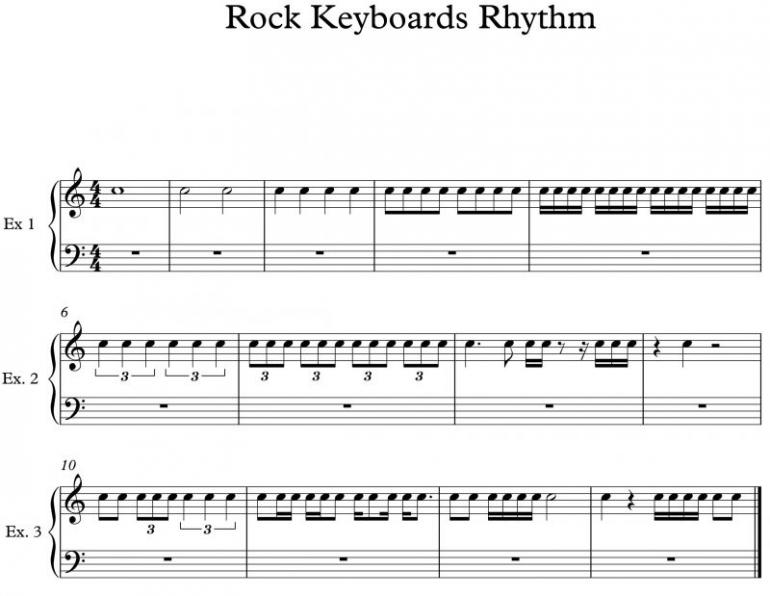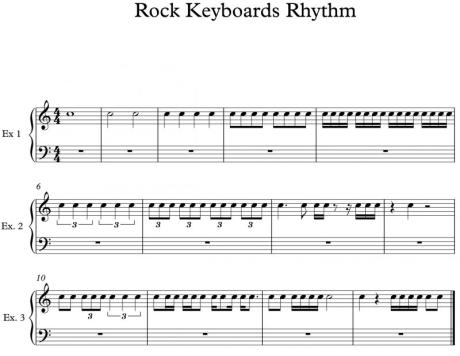Rockové klávesy - Rytmus

Welcome readers! Many excellent rock players can get away with not reading music at all, so it’s very common that a great player can have limited sight reading ability. If you are playing other people’s music, you should definitely spend some time getting it together. Check out this rhythm tutorial to perfect your rhythm reading skills. This article will just focus on rhythm so we’ll use just one note, the C above middle C.
Basics
Most of the music you will play will be in the time signature of 4/4 or 3/4. The top number of the time signature tells you how many beats in the measure or bar. The bottom number tells you which rhythmic value gets one beat. In the case of these two time signatures, the lower number, 4, means the quarter note gets one beat.
In Exercise 1 bar 1 we have a whole note. Being that a quarter note gets one beat, it follows that a whole note gets four beats. In bar 2 we have two 1/2 notes. These notes are 1/2 the rhythmic value of the whole notes. Each one will get two beats. Bar 3 contains all 1/4 notes which get one beat each. Bar 4 has 1/8 notes. These are often barred together. These are 1/2 the value of quarter notes and are often counted 1, and 2, and, 3, and, etc. The last bar of Exercise 1. has 16th notes. These are some of the most difficult rhythms you will be encountering and they can be mixed with rests and 1/8 notes, as you will see in the next examples. In 4/4 time, four 16th notes get one beat and are counted 1, e, and, a.
More advanced rhythms with triplets
In Exercise 2 we start with some more advanced rhythms. Bar 1 features 1/4 note triplets. Three 1/4 note triplets take up the same amount of time as 2 beats. This rhythmic “poly rhythm” of 3 over 2 is from African music and is used by many new groups, Sometimes when learning this figure it’s helpful to beat the 1/4 notes with your feet and count “tri-pa-let, tri-pa-let” in the rhythm with your voice. Bar 2 has 1/8 note triplets which are slightly easier to count; the three triplets now fit over one beat. Listen to the audio example to get the feel.

Dotted rhythms
In Exercise 2, bars 3 and 4, we have some dotted rhythms and rests. A dot after a note equals 1/2 the value of the note. Look at the first two beats in bar 3. The 1/4 note is followed by a dot which we count as an 1/8 note, 1/2 the value of the 1/4 note. The 1/8 note after the dot brings us to the end of beat 2. Beat 3 starts with two 16th notes and an 1/8 note rest. It gets the same rhythmic value as a regular 1/8 note but is silent. On beat four we have a 16th note rest. This rest has one more wavy line on the stem and has the same rhythmic value as a 16th note. The last bar of Exercise 2 starts with a 1/4 note rest, a 1/4 note on beat 2 then a 1/2 note rest. The only rest we haven’t talked about is a whole note rest which is on the bottom of all the systems of music.
Putting it all together
Exercise 3 has everything we’ve learned so far. The tricky parts of Exercise 3 are the different types of triplets in bar 1 and the 16th note rhythms of bar 2, beats 3 and 4. Notice in these beats that 1/8 notes can occur in between 16th notes and that dotted notes can appear anywhere. Listen to the audio examples to get the correct phrasing again.
Fráze a hudební termíny:
Get away with: Když vám něco projde, řeknete „I got away with it“.
Sight reading (reading music): Schopnost číst noty a hrát podle nich.
Time signature: Metrum neboli základní rytmus. Určuje, jak dlouhý je jeden takt a jaké je základní rytmické dělení skladby (například tříčtvrťový rytmus apod.).
Measure, bar: Oba dva tyto výrazy znamenají takt.
Triplets: Trioly.
Dotted rhythms: Tečkované rytmy, tedy takové, ve kterých figurují noty, jejichž délka je jeden a půl násobek původní hodnoty.
Rests: Pomlky, pauzy.
Silent: Pozor, lidé si často pletou „quiet“ a „silent“, protože se většinou obě slova do češtiny překládají jako „tichý“. „Quiet“ ale znamená nízkou hlasitost, zatímco „silent“ nulovou. Dávejme proto na tento rozdíl pozor!




